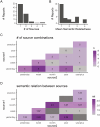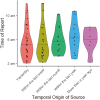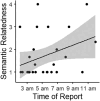Memory updating in dreams
- PMID: 39749230
- PMCID: PMC11694696
- DOI: 10.1093/sleepadvances/zpae096
Memory updating in dreams
Abstract
Robert Stickgold's research was among the earliest to rigorously quantify the effect of learning on dream content. As a result, we learned that dreaming is influenced by the activation of newly formed memory traces in the sleeping brain. Exactly how this happens is an ongoing area of investigation. Here, we test the hypothesis that participants are especially likely to dream of recent experiences, which overlap with well-established semantic networks. We created an artificial situation in which participants encountered new information about a person with which they have extensive past experience-a favorite celebrity. We tracked the effect of novel information about a favorite celebrity on participants' dream content across 3 consecutive nights and queried participants about other recent and remote memory sources of their dreams. While the celebrity manipulation failed to affect dream content, this dataset provides rich descriptive information about how recent and remote memory fragments are incorporated into dreams, and how multiple memory sources combine to create bizarre, imaginative scenarios. We discuss these observations in light of the proposed "memory updating" function of sleep-dependent memory consolidation, as well as Stickgold and Zadra's NEXTUP (Network Exploration to Understand Possibilities) model of dreaming. This paper is part of the Festschrift in honor of Dr Robert Stickgold.
Keywords: dreaming; dreams; hippocampus; memory; memory consolidation; memory updating; sleep.
© The Author(s) 2024. Published by Oxford University Press on behalf of Sleep Research Society.
Conflict of interest statement
The authors have no other disclosures to make.
Figures






Similar articles
-
A meta-analysis of the relation between dream content and memory consolidation.Sleep. 2023 Dec 11;46(12):zsad111. doi: 10.1093/sleep/zsad111. Sleep. 2023. PMID: 37058584
-
Dreaming during REM sleep: autobiographically meaningful or a simple reflection of a Hebbian-based memory consolidation process?Arch Ital Biol. 2018 Sep 1;156(3):99-111. doi: 10.12871/00039829201832. Arch Ital Biol. 2018. PMID: 30324606 Review.
-
The memory sources of dreams: serial awakenings across sleep stages and time of night.Sleep. 2023 Apr 12;46(4):zsac292. doi: 10.1093/sleep/zsac292. Sleep. 2023. PMID: 36462190 Free PMC article.
-
Dreaming and offline memory consolidation.Curr Neurol Neurosci Rep. 2014 Mar;14(3):433. doi: 10.1007/s11910-013-0433-5. Curr Neurol Neurosci Rep. 2014. PMID: 24477388 Free PMC article. Review.
-
Dreaming of a learning task is associated with enhanced memory consolidation: Replication in an overnight sleep study.J Sleep Res. 2019 Feb;28(1):e12749. doi: 10.1111/jsr.12749. Epub 2018 Aug 8. J Sleep Res. 2019. PMID: 30091247 Free PMC article.
References
-
- Dement WC, Kahn E, Roffwarg HP.. The influence of the laboratory situation on the dreams of the experimental subject. J Nerv Ment Dis. 1965;140:119–131. doi: https://doi.org/10.1097/00005053-196502000-00002 - DOI - PubMed
-
- De Koninck JM, Koulack D.. Dream content and adaptation to a stressful situation. J Abnorm Psychol. 1975;84(3):250–260. doi: https://doi.org/10.1037/h0076648 - DOI - PubMed
-
- Fiss H, Kremer E, Litchman J.. The mnemonic function of dreaming. Sleep Research. 1977;6:122.
-
- Foulkes D, Rechtschaffen A.. Presleep determinants of dream content: Effect of two films. Percept Mot Skills. 1964;19:983–1005. doi: https://doi.org/10.2466/pms.1964.19.3.983 - DOI - PubMed
-
- Domhoff GW. Dreams are embodied simulations that dramatize conceptions and concerns: The continuity hypothesis in empirical, theoretical, and historical context. Int. J. Dream Res. 2011;4(2):5062.
LinkOut - more resources
Full Text Sources
Research Materials
Miscellaneous

